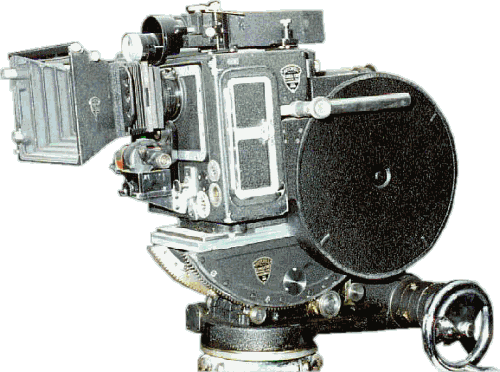|
|
This topic comprises 4 pages: 1 2 3 4
|
|
Author
|
Topic: Improve 35mm
|
|
|
|
|
Bobby Henderson
"Ask me about Trajan."

Posts: 10973
From: Lawton, OK, USA
Registered: Apr 2001
|
 posted 02-24-2006 10:29 PM
posted 02-24-2006 10:29 PM




I would be all in favor of bringing back VistaVision style 35mm photography. 8/35 production would be great for standard 1.85:1 shows and "Technirama" style anamorphic photography would deliver better looking 'scope movies.
But there's not much in the way of new cameras and lens systems to do 8/35 motion picture photography. The magazine loads sideways. Has anyone ever built a VistaVision camera that could mount atop a Steadicam and not require a professional body builder's strength to wield it?
55mm production is an even longer shot. First, CinemaScope55 never really got its legs under it. I mean, how many movies were shot in the format? Carosel and The King and I were about it, right? Actual CinemaScope55 camera gear, lenses, reduction printers, etc. have got to be very rare. On top of that, is it really necessary to revive that 55mm format when the 8-perf 65mm/70mm format is far more established?
The other incremental ways to improve 35mm production are all valid to use in making movies. But the 35mm method for showing movies is going to quickly turn into an endangered species.
I figured 35mm projection would be around for a long time, but that was until Carmike Cinemas issued their recent announcement they would install 2K Christie digital projection systems circuit-wide by the end of 2007. That's over 2400 screens. I was fairly stunned back in 1994 when AMC Theatres said they would eventually install SDDS on all their screens (did they actually reach that goal?). This annoucement is quite a bit larger in scale. And I doubt Carmike will be alone in making such annoucements. I expect AMC/Loews, Regal, Cinemark and others to make similar annoucements soon. Some of those guys may finish their D-Cinema conversions before Carmike (although I think Carmike has already started their plan).
So right now there may not be much of an issue in improving 35mm prints. New 35mm release prints may become a scarce item by 2010 and all but gone a couple or so years after that. Perhaps some might be produced for a few theaters that want to play them and be regarded like those audiophiles who prefer vinyl records for music listening.
In the long run 70mm film prints may be the only kind of film prints left being shown. There's a strong chance you'll only find film reels and platters in IMAX and 8/70 special venue theaters in just a few years.
But I'm hoping new 5/70 systems can be installed in some of these new, luxury theaters with giant screens, balcony areas with cash bars and all sorts of other high end features. What's wrong with putting a 70mm print in there, whether it's a blow up from 35mm or originated in 65mm? Many of the customers are already paying a premium to watch a movie in such an auditorium, just like they do when watching a IMAX DMR show. The movie company is still making more money off that big auditorium. If they invest in putting a better quality film print into such auditoriums they'll probably get more and more people back into such theaters for repeat visits and make more money off of it.
Really, if a few people within the film distribution end of things worked with some folks on the exhibition end of things they could easily develop a marketing and business plan to bring back big movie palaces. Sure, it's a huge auditorium (or a number of them) tacked onto a "megaplex" but the inside of that auditorium would still seem pretty similar to a palace auditorium of long ago.
Or to put it more simply: they could take IMAX' idea, do it a little more efficiently and compete with them on it.
The distributors could have the best of both worlds. Beam movies via satellite to the video projectors of 99% of theaters around the country, and then strike 100 70mm prints to play in big palacial theaters to get across that positive "halo effect" in advertising to show the movie in its best, and most nostalgic, classic, form.
| IP: Logged
|
|
|
|
|
|
|
|
|
|
|
|
|
|
|
|
|
|
|
|
Monte L Fullmer
Film God

Posts: 8367
From: Nampa, Idaho, USA
Registered: Nov 2004
|
 posted 02-27-2006 03:16 AM
posted 02-27-2006 03:16 AM




Interesting topics that John presented here. With reading the topics especially about the "Titanic" movie, I could easily see myself as that projectionist, for I did play "Titanic" on a 33x65 ft screen with just under a 100 ft throw in a house that seated 410 people with illumination from a 4500w bulb.
..and I fully agree what was posted in that article: dim lighting to make a dull picture, washed out contrasts, hard to read end credits, et.al. - all evident of a 35mm presentation that should have been a 70mm presentation on such a huge screen.
Later on, we were playing "Titanic" on smaller screens in this megaplex, and all of a sudden, the film was more enjoyable to watch due to the increased sharpness, brighter screen illumination and the end titles definitely readable.
-Monte
| IP: Logged
|
|
|
|
|
|
|
|
All times are Central (GMT -6:00)
|
This topic comprises 4 pages: 1 2 3 4
|
Powered by Infopop Corporation
UBB.classicTM
6.3.1.2
The Film-Tech Forums are designed for various members related to the cinema industry to express their opinions, viewpoints and testimonials on various products, services and events based upon speculation, personal knowledge and factual information through use, therefore all views represented here allow no liability upon the publishers of this web site and the owners of said views assume no liability for any ill will resulting from these postings. The posts made here are for educational as well as entertainment purposes and as such anyone viewing this portion of the website must accept these views as statements of the author of that opinion
and agrees to release the authors from any and all liability.
|

 Home
Home
 Products
Products
 Store
Store
 Forum
Forum
 Warehouse
Warehouse
 Contact Us
Contact Us




 Printer-friendly view of this topic
Printer-friendly view of this topic






![[thumbsup]](graemlins/thumbsup.gif)



![[Cool]](cool.gif)




